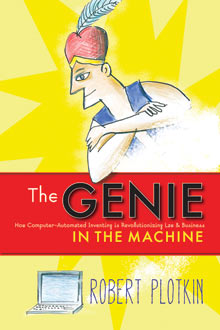Genius, Thomas Edison famously said, is 1 percent inspiration and 99 percent perspiration. But now that inventors are relying more and more on computers, invention is becoming far less sweaty. As the process of inventing is transformed, the way products are patented must change too, says Robert Plotkin ‘93, author of The Genie in the Machine: How Computer-Automated Inventing Is Revolutionizing Law and Business.

By Robert Plotkin ’93
Stanford University Press
2009, $29.95
Tools such as 3-D modeling and digital prototyping have already taken much of the grunt work out of invention. With the advent of genetic programming and other machine learning techniques, however, software stands poised to take over higher-level aspects of invention as well; these “genies” could conjure up products on the basis of nothing more than general human “wishes.” The Oral-B CrossAction Toothbrush, for example, was designed in part using software. The U.S. Patent and Trademark Office has already granted patents to other products designed largely by software.
While Plotkin welcomes the way digital tools are expanding human ingenuity, he worries that the legal system for protecting inventions and intellectual property will lag behind technological advances. “There are simple rules of patent law that were developed in the industrial age, and they work well for industrial-age technology,” he says. “But they don’t work well when you apply them to this new way of inventing.”
There’s a lesson to be learned from recent history, says Plotkin, who graduated from MIT with a degree in computer science in 1993–a heady time to be in computing. By the mid-’90s, when Plotkin was studying law at Boston University, the browser wars were in full swing as software makers battled for control over the fledgling market. At the same time, the patent office was granting thousands of software patents, many so broad as to have a stifling effect on innovation.
Like many of the digerati, Plotkin thinks of the broad software patents of the ’90s as an unfortunate error–the result of a legal system that was unprepared for a revolution in technology, as may again be the case today. If we don’t set higher standards in deciding what is truly innovative, Plotkin argues, we risk being swamped with trivial patents for plans that an inventor armed with a decent genie could turn out in an afternoon–patents that don’t reflect true human ingenuity.
“If we don’t pay attention to this now, we will go through a period of bad patents,” he says. “But I don’t think it’s necessary.”
The good news, Plotkin says, is that genies are going to heighten the creative powers of the average person dramatically. Combined with the flourishing of fabrication technologies such as three-dimensional printers, he says, automatic invention software could give anyone the skills of a trained artisan.
“People usually think of the computer either purely as a slave-like tool or as a competitor–something that’s going to make us obsolete. The computer as a symbiotic organism is a different way of thinking about it,” he says. “We’re too focused on thinking of our minds as being just what is inside our brains.”
Keep Reading
Most Popular
Large language models can do jaw-dropping things. But nobody knows exactly why.
And that's a problem. Figuring it out is one of the biggest scientific puzzles of our time and a crucial step towards controlling more powerful future models.
The problem with plug-in hybrids? Their drivers.
Plug-in hybrids are often sold as a transition to EVs, but new data from Europe shows we’re still underestimating the emissions they produce.
Google DeepMind’s new generative model makes Super Mario–like games from scratch
Genie learns how to control games by watching hours and hours of video. It could help train next-gen robots too.
How scientists traced a mysterious covid case back to six toilets
When wastewater surveillance turns into a hunt for a single infected individual, the ethics get tricky.
Stay connected
Get the latest updates from
MIT Technology Review
Discover special offers, top stories, upcoming events, and more.